Losing a person with whom you have a close relationship is never an experience to look forward to. However, as sad as it may be, losing loved ones is an inevitable human experience. Therefore, over time, humans have devised means of expressing their final farewells through speeches about the deceased during the funeral process, which has become a tradition for many worldwide. This type of speech is known as an eulogy. In this article, we have provided you with a guide on how to compose it, along with many professionally crafted templates.
Composing a eulogy can be tricky and overwhelming, especially considering that it is a period filled with grief and sorrow. This article will help alleviate the process by highlighting tips for writing an effective one and providing templates that make the process even easier.
What is a Eulogy?
A eulogy is a verbal or written speech that commends the life of a deceased person.
It primarily commemorates a dead person’s life and vividly projects the life they lived onto the audience’s minds. However, it can also be a speech used to appreciate and celebrate a person’s life, impact, and achievement while they are still alive – usually at retirement or a send-forth party.
The word “eulogy” originated during the 15th century from Latin (eulogium) and Greek (eulogia) words, which mean “praise; good or fine language”. “Eu” means “well,” and “logia” means “speaking” or “words”. Together, it means “speak well”.
Free Eulogy Templates
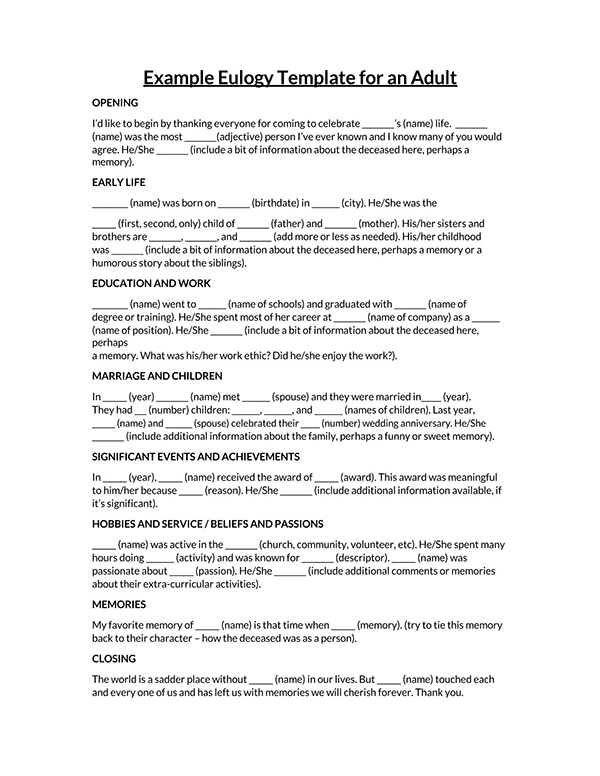
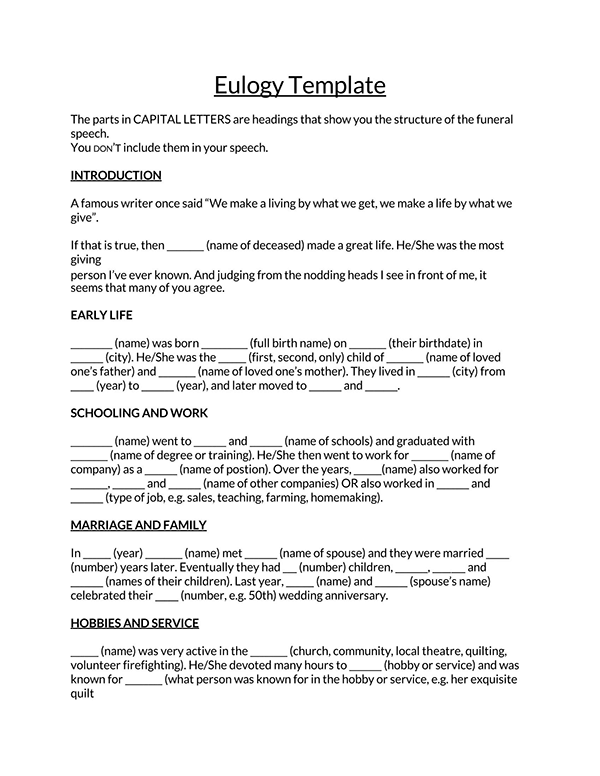
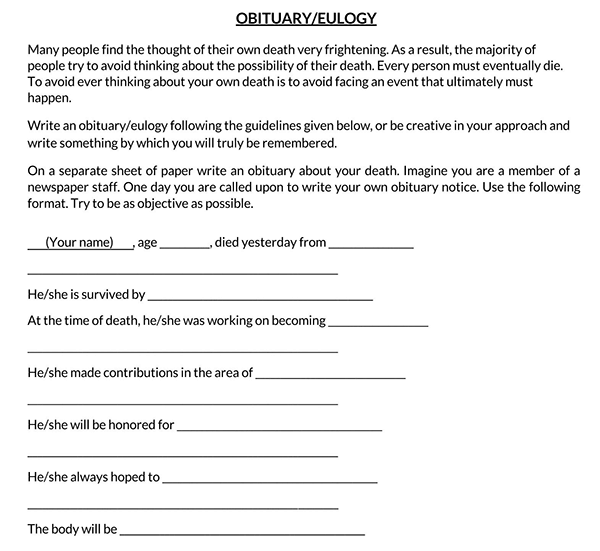
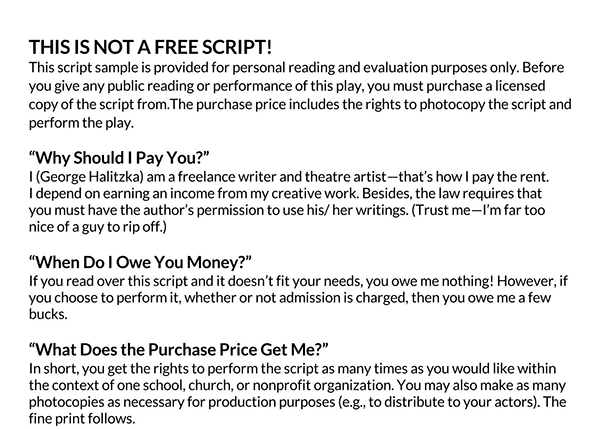
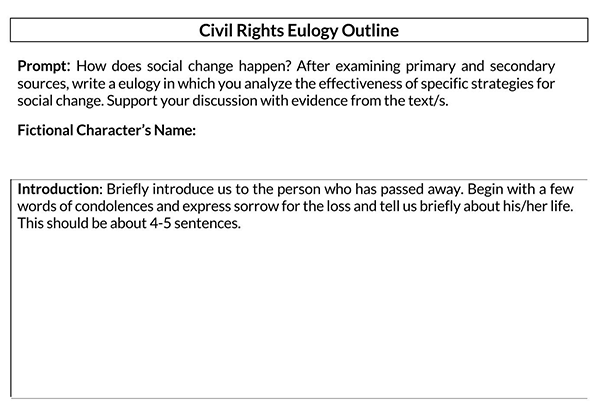
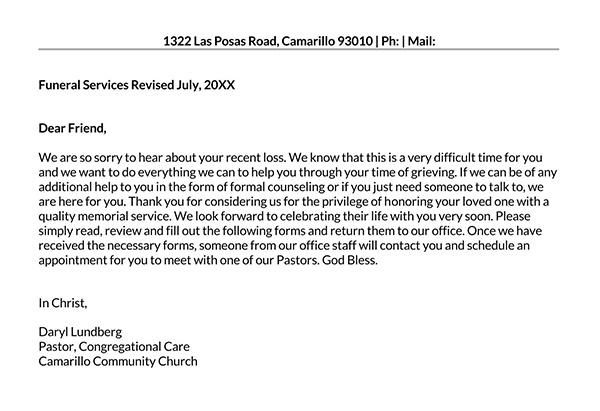
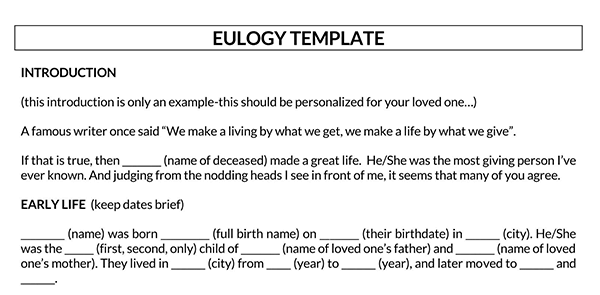
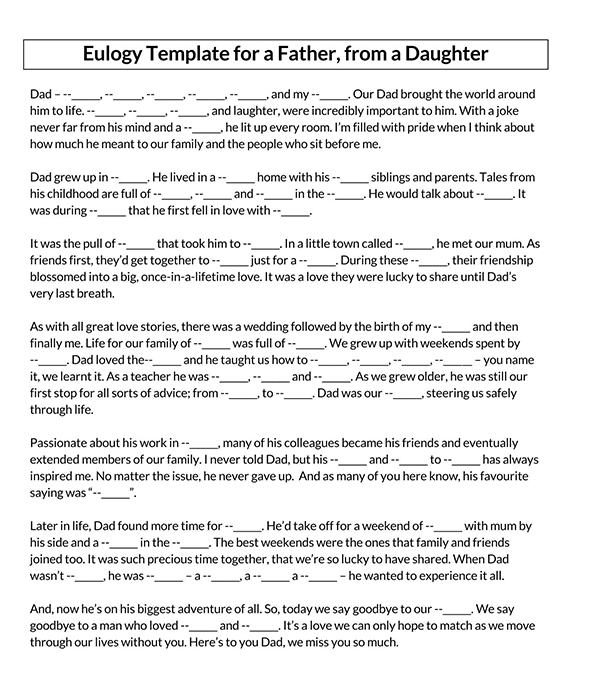
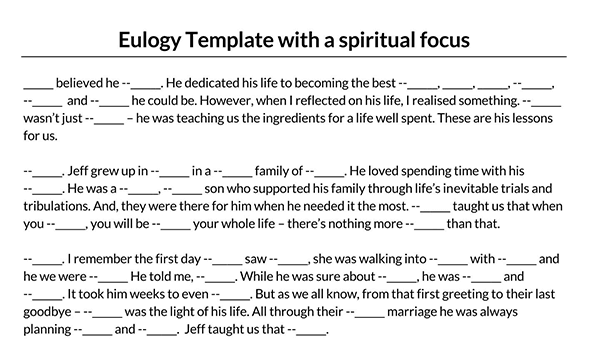
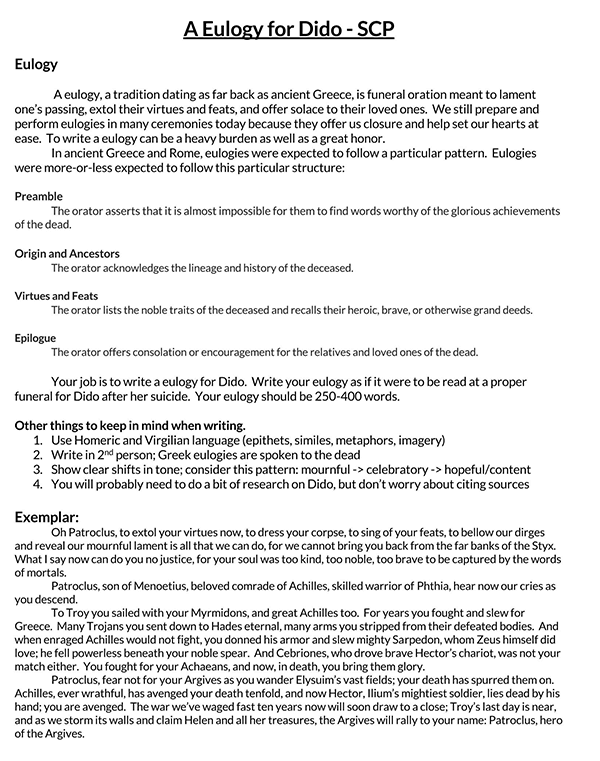
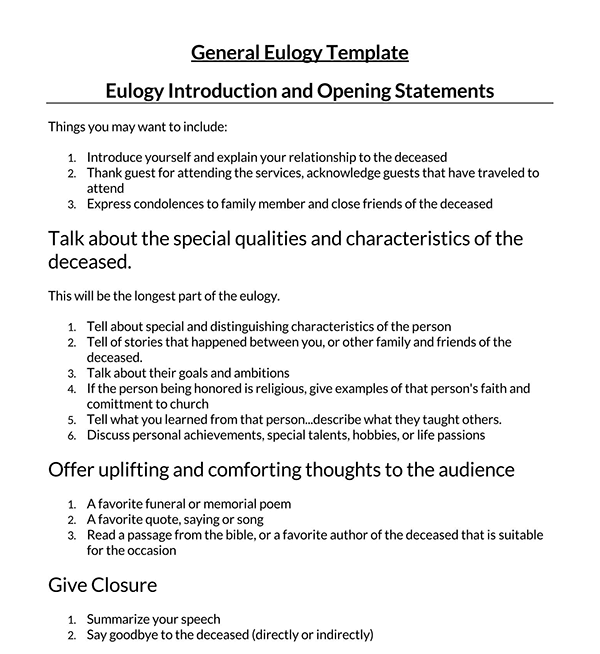
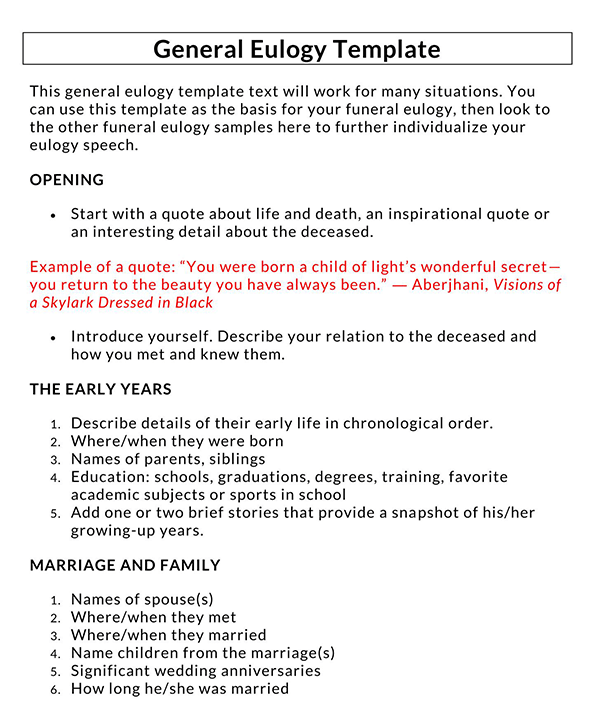
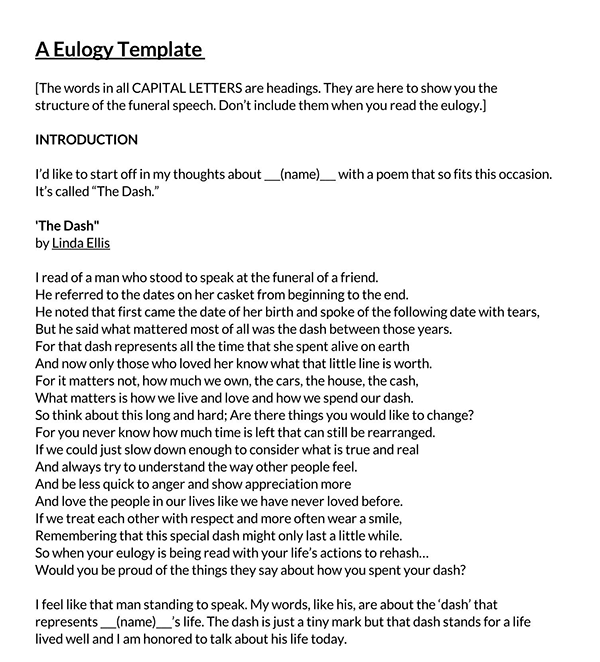
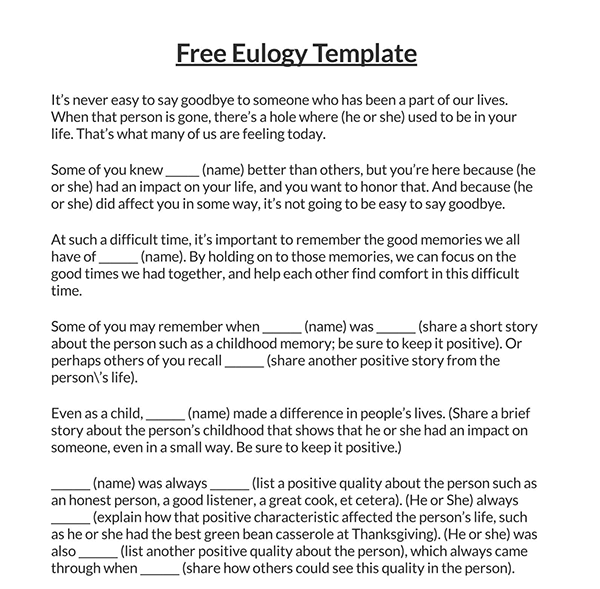
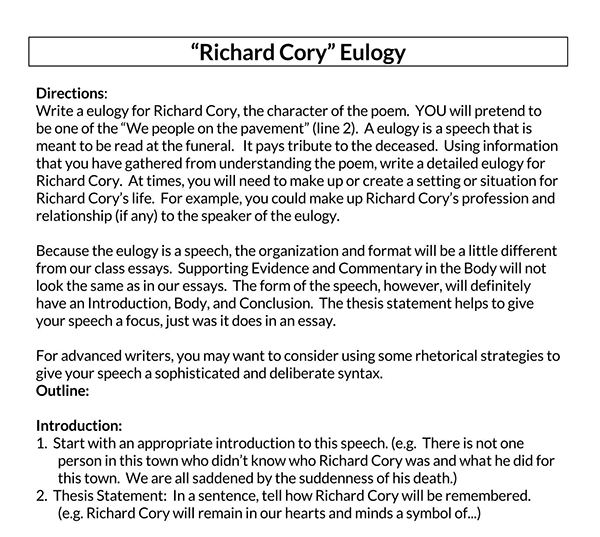
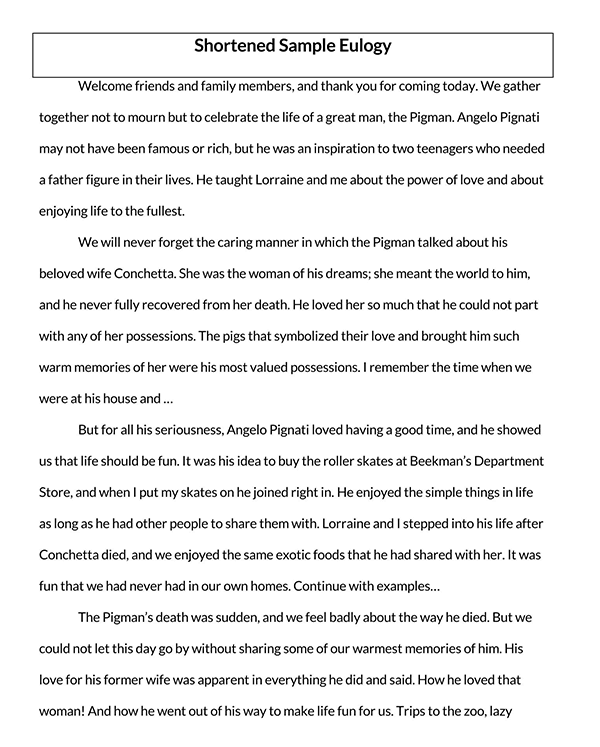
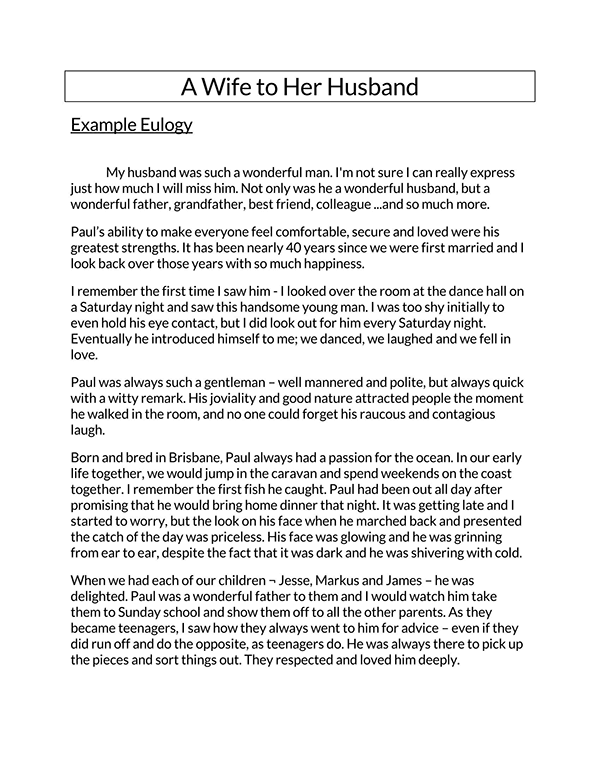
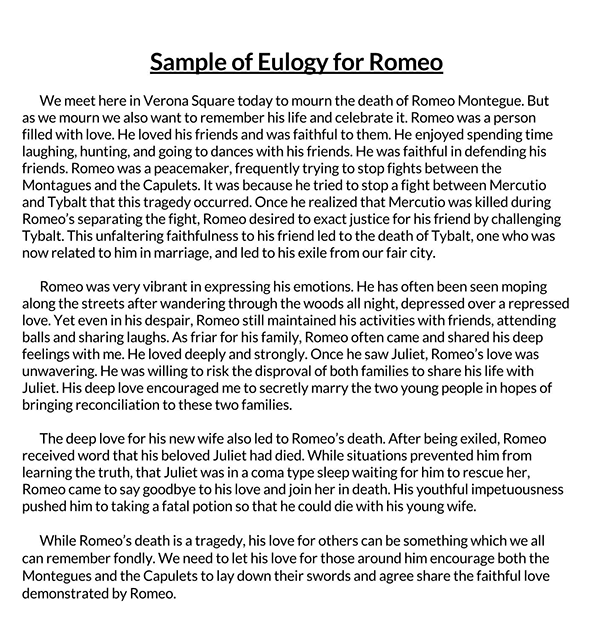
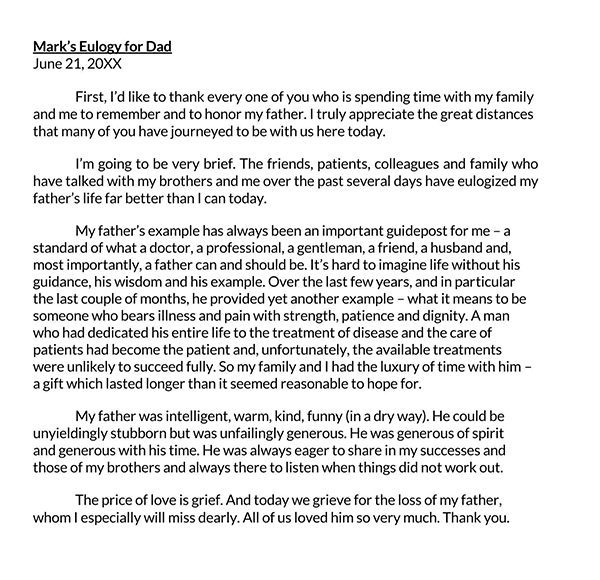
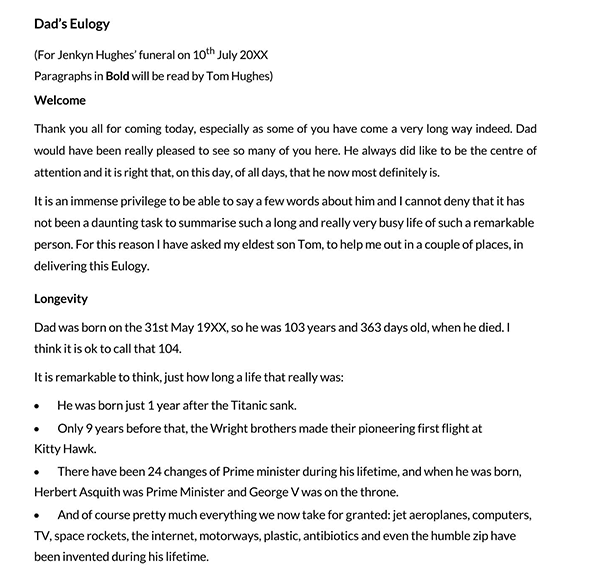
Writing a Perfect Eulogy
Writing a eulogy is no easy task, but here is a systematic guide to making it easier and more accurate to capture the loved one’s memory:
Phase 1: Brainstorming
Writing a eulogy for the dead can be tedious, especially if the person died young or tragically. To facilitate the process, start by brainstorming. Think about the audience, the deceased, and their loved ones. Note down some affectionate or exceptional recollections of the dead, along with vital information about their birth, graduations, anniversaries, and deaths that will illuminate the person’s essence.
This section will guide you on what to write and what memories to tenderly hint at or outrightly avoid:
How will they feel?
A eulogy is a powerful recollection that will evoke emotions in the audience. The audience will generally be sad, and some of them might be in tears. Try to lighten the somber mood by embedding inspirational and uplifting content about the deceased in it. The audience will appreciate this.
What do they want to hear?
Most people want to remember only the good deeds of their loved ones and will want the audience to have a positive image of the deceased. Therefore, it is wise to speak about the deceased’s good acts, jokes, or achievements that will capture their essence in a constructive light. On the other hand, there are subtle and acceptable ways to mention a deceased person’s shortcomings without dwelling on them.
How long should it be?
Each speaker in a funeral program might have a time allotment. The eulogy should fit into that time without encroaching on another speaker’s time. In the absence of a time limit, keep it short within minutes (5 minutes on average) to maintain the audience’s attention. Inversely, a too-short one signifies a lack of effort to celebrate the loved one.
Phase 2: Composing a eulogy
The following is a standardized outline to compose the best eulogy:
Introduce yourself and your loved one
The speaker should introduce themselves and the relationship they shared with the deceased. Then, they can talk briefly about the deceased’s life, birthday, death, parents, siblings, education, and accomplishments. In addition, during the introduction, if the eulogizer is a member of the immediate family, they should appreciate the audience’s time and support during a difficult time.
Basic information about the deceased
The speaker could speak on any memory or event during the deceased’s early life, childhood, or school adventures. The speaker does not need to recount all that happened—this will be long and lose the audience’s attention—but should highlight significant events that illustrate the deceased’s life.
EXAMPLE
The loved one could talk about how the deceased made friends with victims of bullying in their school.
Career, occupation, achievements, and interests
This area is where a loved one can draw on materials to demonstrate the deceased’s life. A person’s occupation, interests, career, and achievements powerfully exhibit their core values and what occupies most of their time.
EXAMPLE
The loved one could talk about why their father became a medical doctor or why he volunteered every year at the teenager’s summer retreat.
Include family
Structure it to highlight the deceased’s commitment to their family and family values. An example can be a time when the deceased helped a distant family member in trouble.
Share your memories
Numerous memories are shared with the deceased, especially for immediate loved ones like family members, religious members, club members, and colleagues. Some memories are famous, while others are not or are specific to individuals. A loved one can recount any one or a mixture of stories to exemplify the deceased’s influence in their life. This vibrantly projects the heart of the deceased to the audience.
Use specific examples to describe the person
Specific examples are stories about the deceased that bring their core closer to the audience. A recollection of a shared trip with the deceased, their advice, the assistance they rendered, etc., can help describe the deceased explicitly. A highlight of the person’s interest, hobby, or uniqueness portrays them better to the audience.
EXAMPLE
During a bird-watching hike that we had some years ago, Collins took the time to teach me how to recognize the birds’ mid-flight and stayed behind with me to catch my breath. He did not make me feel inept or that I was dragging down the group.
Closing (say thank you and say goodbye)
The speaker may use a quote, poem, or extract to end the eulogy. Remember to appreciate those who supported the family during the tough time and those present at the memorial. A simple, heartfelt goodbye to the deceased is also an effective close. State the deceased’s name with any bit of expressions of parting such as,
We will miss you dearly. You are gone, but you will remain forever in our hearts. Rest in peace.
Last Minute Tips for You
The tips listed below are essential to writing a good and moving eulogy that will illuminate the deceased’s life:
Decide on the tone
The tone could decide if the funeral service will move forward as a light-hearted service or a solemn one. The cause of death, age, personality, or wishes of the deceased could also set the tone.
Write it word for word
Writing down the entire eulogy is not compulsory, but it is necessary if the speaker plans to recite a literary piece or quotation. It is best to use speaking prompts instead to ensure suitable emotional delivery. You can also play some uplifting funeral songs in memory of the deceased to end on a lighter note.
Get feedback
It is recommended that the eulogizer ask close family members or friends of the deceased to scrutinize the draft for any mistakes, update facts, or remove improprieties. Doing this provides an additional check for accuracy.
Keep it conversational
Write the eulogy in a conversational tone, just like speaking with friends and family. This makes it riveting.
Share your eulogy
Eulogies are beautiful pieces immortalizing the deceased, and those who attended the funeral service or were absent should have a copy of it to celebrate the deceased beyond the service. Print and share copies of the eulogy with people during and after the service and publish it online. Share a copy with a trusted person who can finish it if, for emotional reasons, the eulogizer cannot.
Avoid perfection
A typical conversation is habitually imperfect, and the eulogy should flow like a normal conversation. This helps to connect with the listeners better and guides the speaker against mistakes during delivery.
Rehearse the eulogy
Rehearse the eulogy before the memorial service. The speaker should first sound out the words of the eulogy to themselves to judge their appropriateness. In addition, the speaker could read it in the mirror or other people to evaluate the effectiveness of the eulogy and review it. This helps to avoid mistakes during the actual delivery and adequately manages the emotions.
Use a conversational tone
The speaker should deliver the eulogy in a conversational tone and make eye contact with the audience to keep them interested and focused.
Speak slowly
During the delivery, the speaker should pause when needed and speak in a slow, unhurried tone. This connects with the audience but does not drag the words. In addition, it helps to keep anxiety at bay and helps select words that convey the message better carefully.
Memorize much
Do not read the eulogy directly off the page. In addition, memorizing the content of the eulogy might be harmful during delivery. Emotions will be high, and the speaker might forget some memorized words. This will interrupt the flow of the speech. Instead, have a list of prompts that cover essential areas of the eulogy, which can be consulted quickly during the speech.
Overcome your emotions
There is no right or wrong way of delivering a eulogy, and the last thing the loved one should worry about is how to rein in their emotions. If overcome with emotions, the loved one should pause briefly before they continue. The display of emotions might help others to connect to the loss and the message of the eulogy.
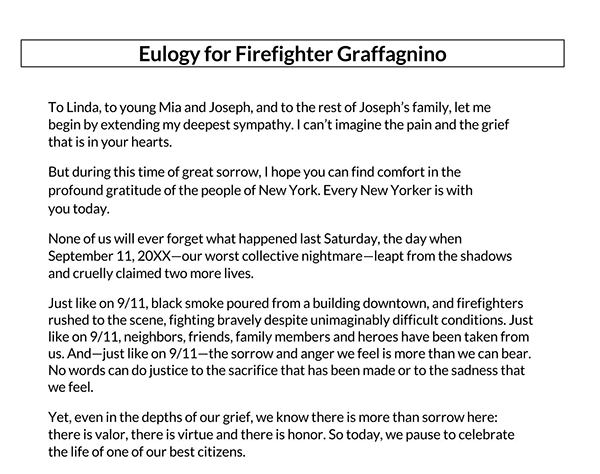
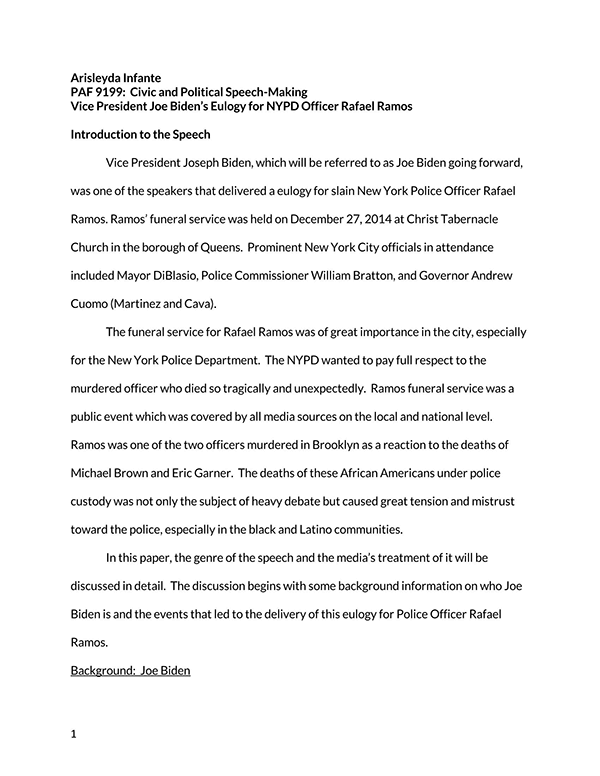
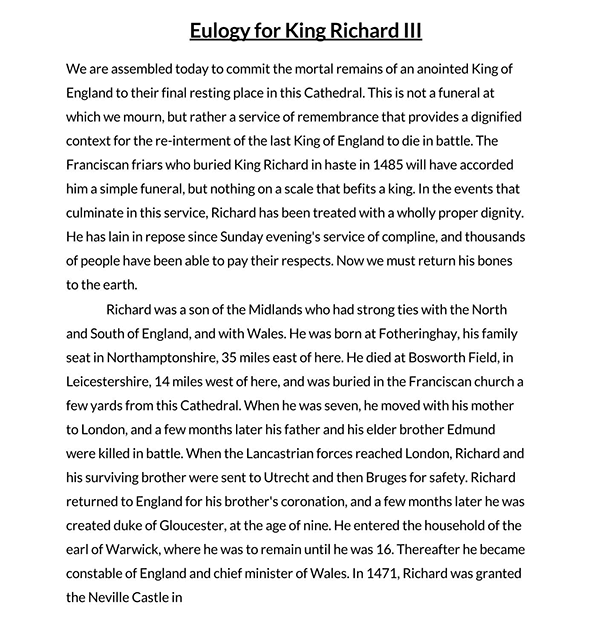
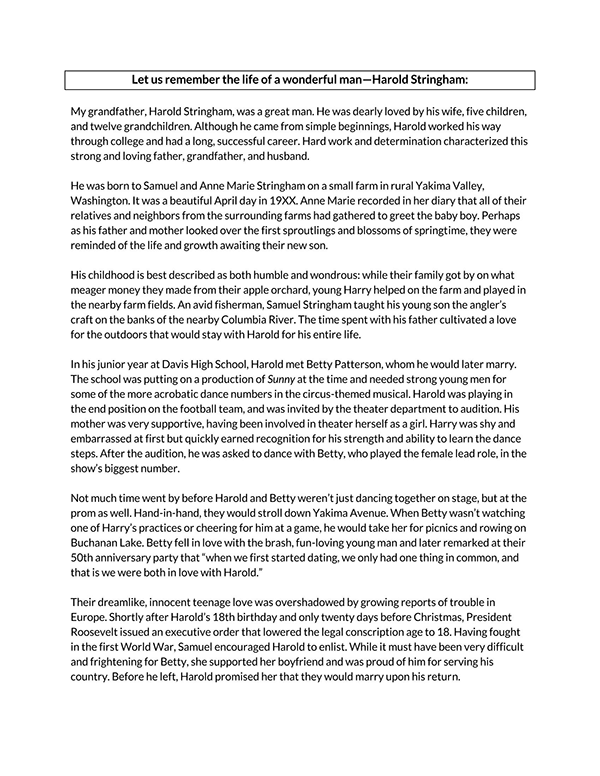
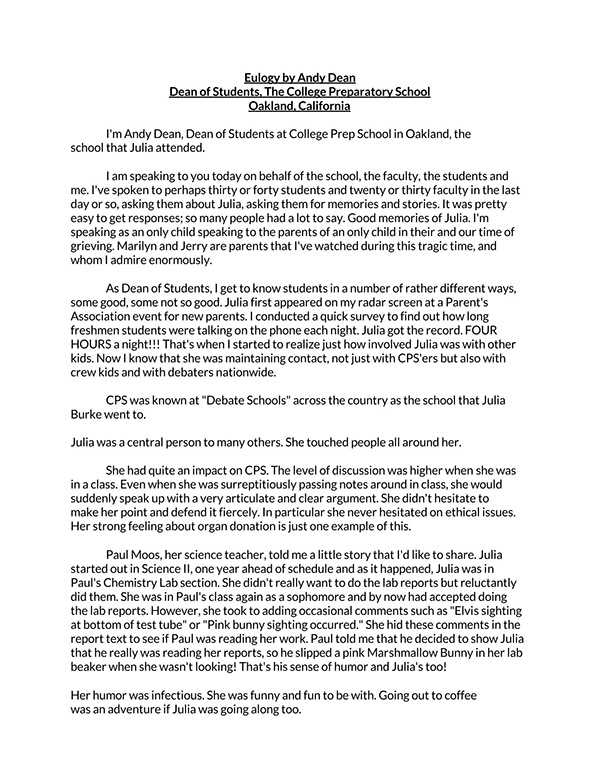
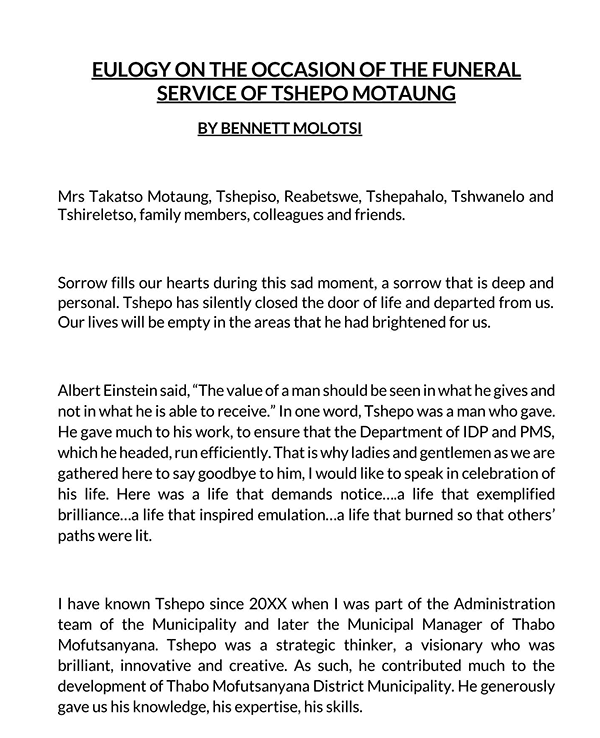
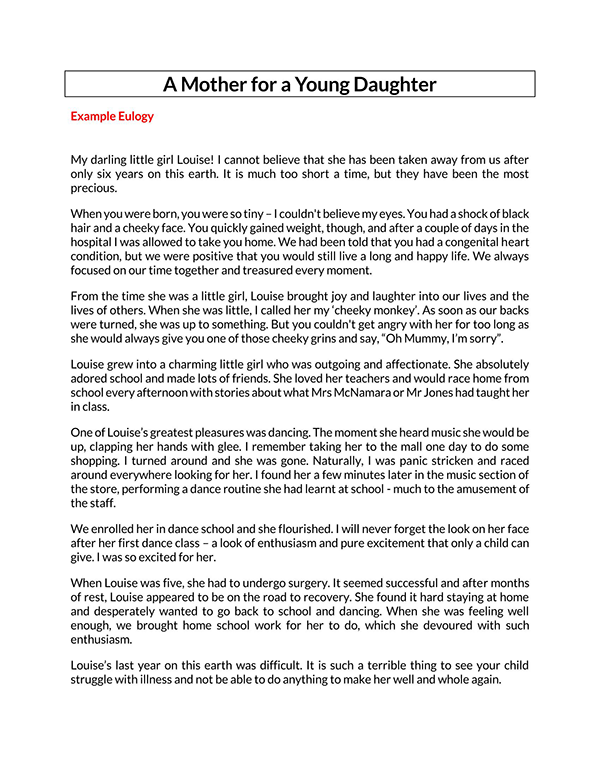
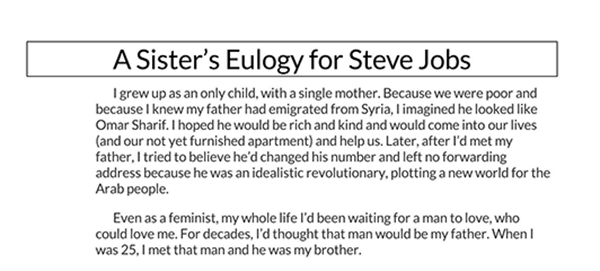
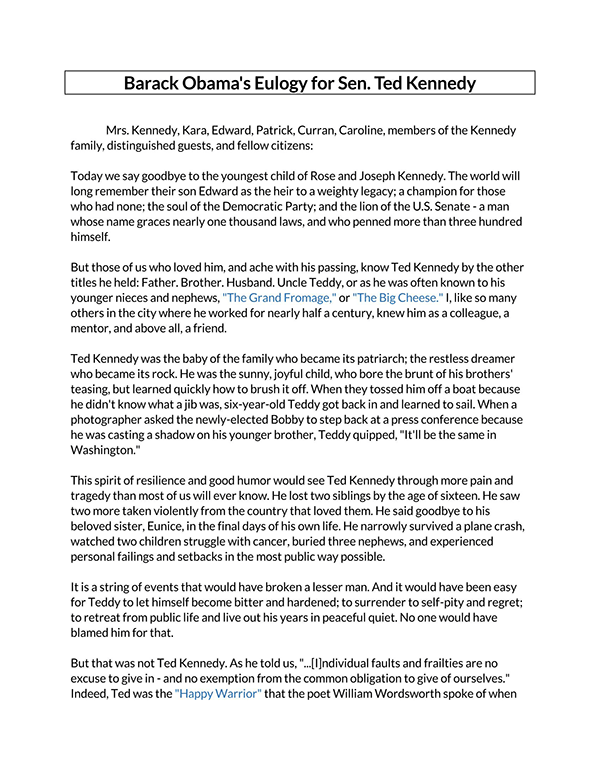

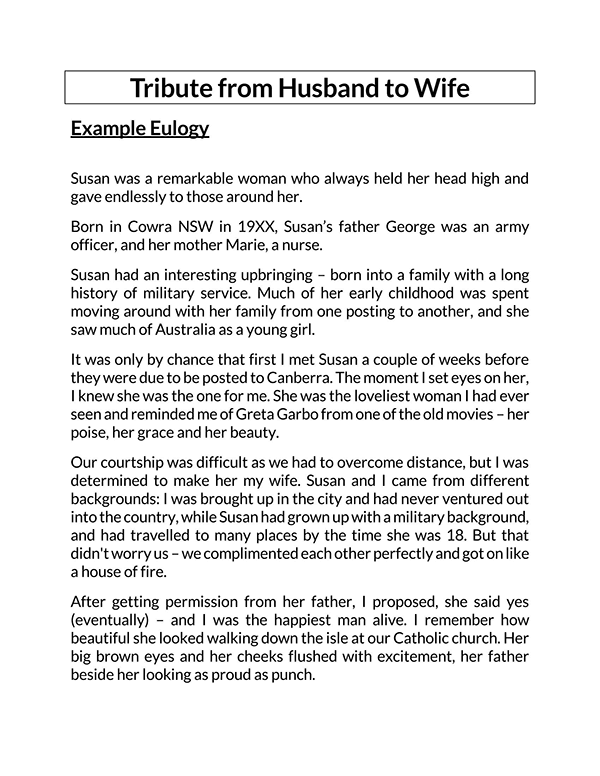

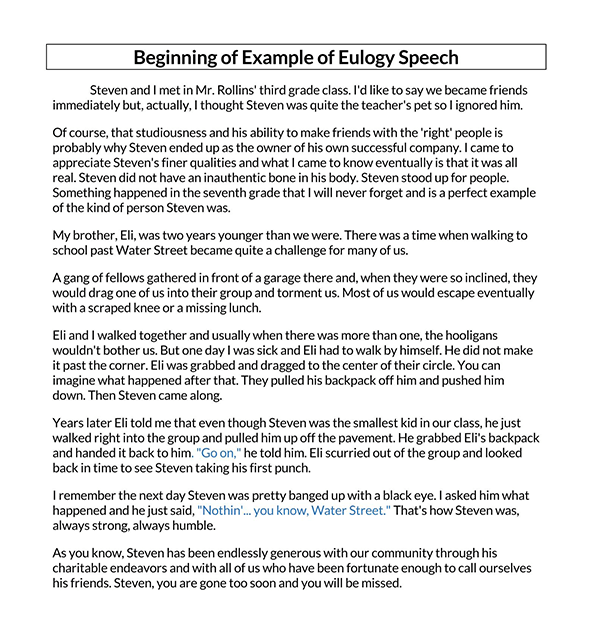
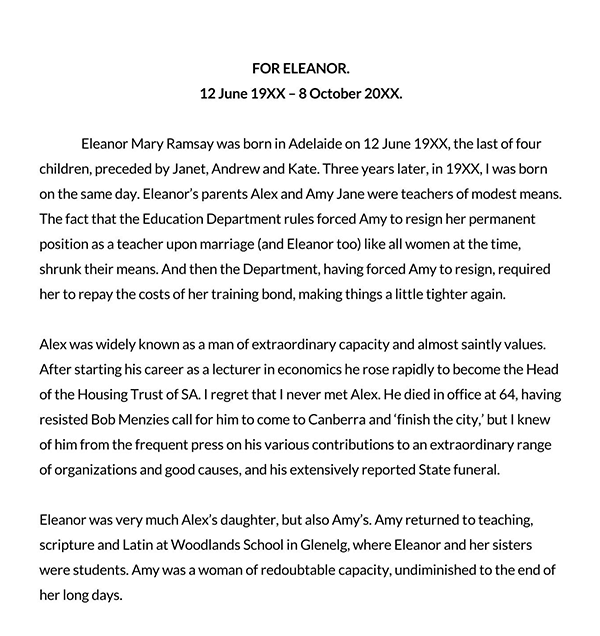
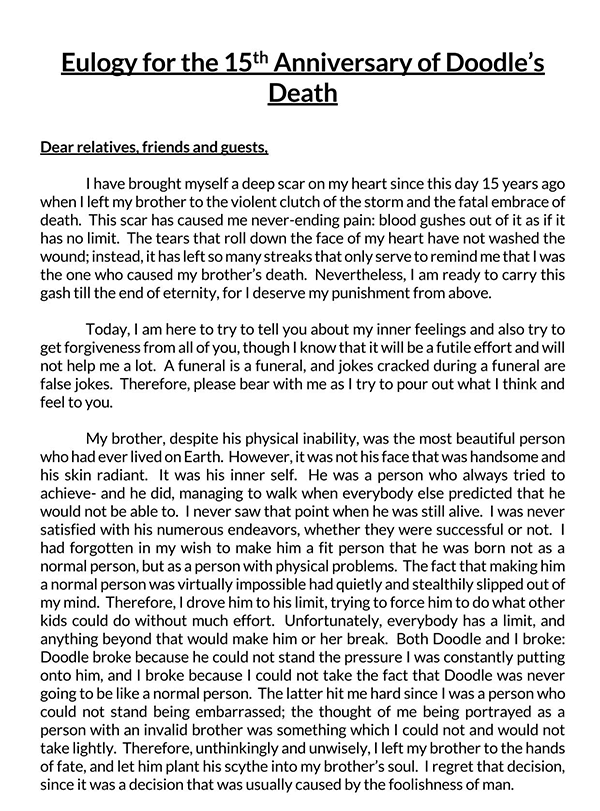
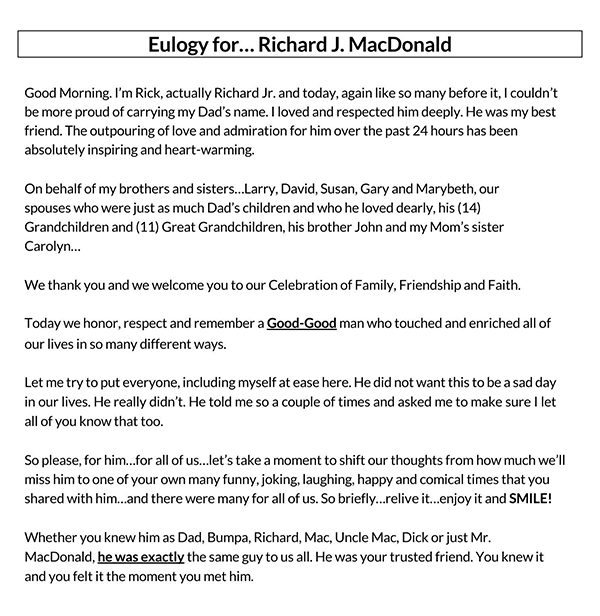
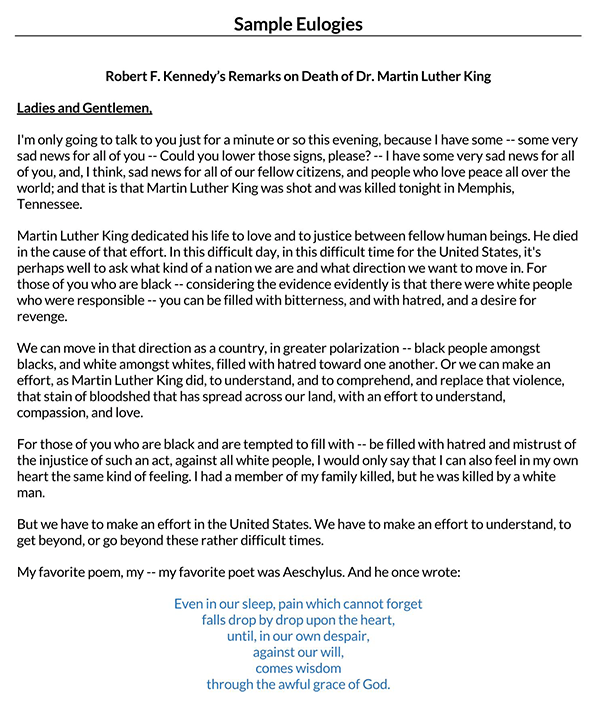
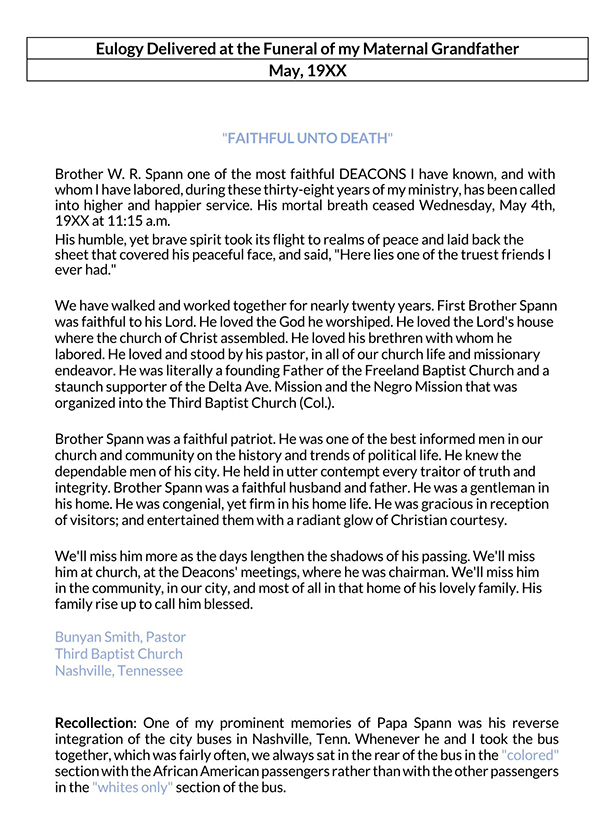
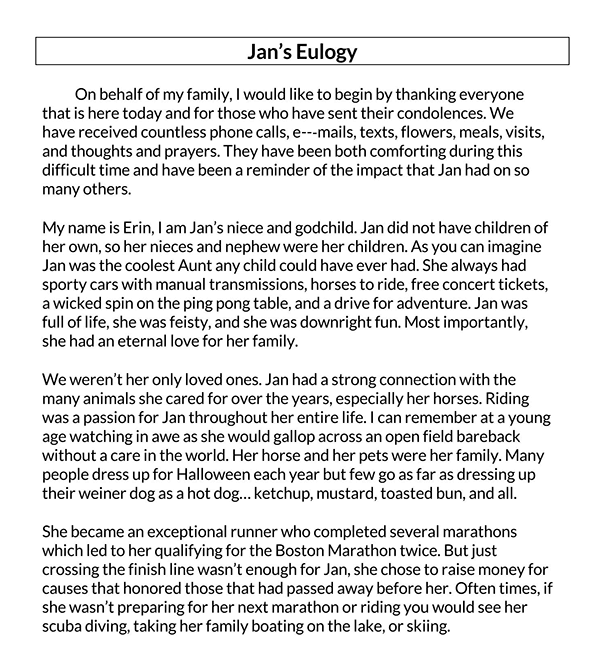
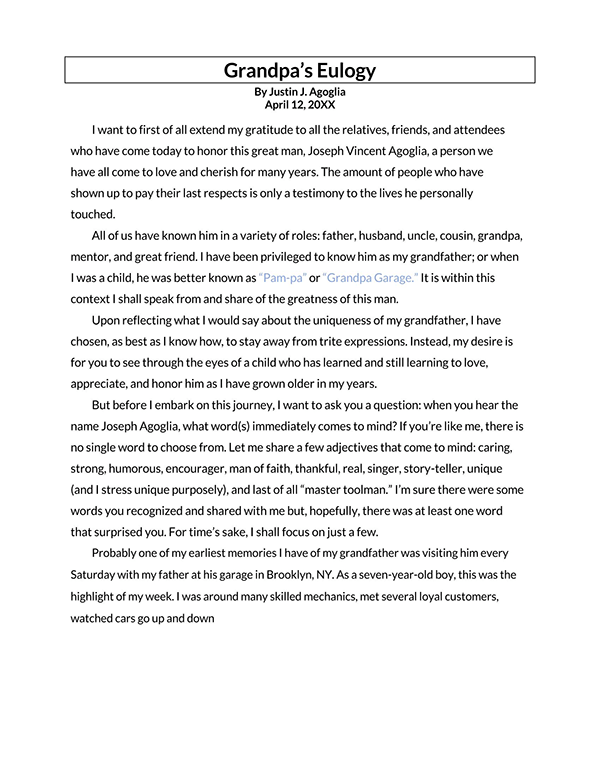
Effective Practices for Giving a Eulogy
Leverage the practices listed below to deliver an effective and lasting eulogy:
Rehearse
Rehearse before the memorial service. The speaker should first sound out the words themselves to judge their appropriateness. In addition, the speaker could read it in the mirror or ask other people to evaluate its effectiveness and review it. This helps to avoid mistakes during the actual delivery and adequately manages the emotions.
Use a conversational tone
The speaker should deliver it in a conversational tone and make eye contact with the audience to keep them interested and focused.
Speak slowly
During the delivery, the speaker should pause when needed and speak in a slow, unhurried tone. This connects with the audience but does not drag the words. In addition, it helps to keep anxiety at bay and helps select words that convey the message more carefully.
Memorize most
Do not read directly off the page. In addition, memorizing the content might be harmful during delivery. Emotions will be high, and the speaker might forget some memorized words. This will interrupt the flow of the speech. Instead, have a list of prompts that cover essential areas, which can be consulted quickly during the speech.
Overcome your emotions
There is no right or wrong way of delivering a eulogy, and the last thing the loved one should worry about is how to rein in their emotions. If overcome with emotions, the loved one should pause briefly before they continue. The display of emotions might help others connect to the loss and the message.
Key Takeaways
- A eulogy is a commendation of the deceased’s life while alive. It covers their triumphs, lifestyles, and legacies.
- To write a good one, the loved one should go through memorabilia like photo albums. In addition, they should think about the deceased’s life from birth to death, values, successes, family, education, and hobbies. The writer may also consult people who shared memories with the deceased.
- Keep it brief, light-hearted, and heartfelt. Use a conversational tone, avoid perfection, and share it with others at the service or online.
- Use one of the downloadable templates to help facilitate the writing process, as they are easy to use and highly customizable.




